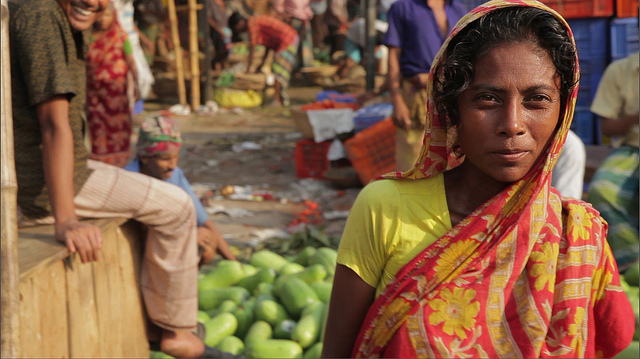As microfinance institutions (MFIs) grow in many countries worldwide, debate continues over whether such programs truly benefit the poor. Proponents emphasize the need for innovative ways to provide poor populations access to financial services. Critics argue any successes may be temporary because microfinance programs require training and entrepreneurship skills, which many poor populations lack. In addition, some fear that beneficiaries may be charged high interest rates or become dependent on MFIs, borrowing more than they can pay back and becoming further trapped in poverty.
Beyond Ending Poverty, a new book published by the World Bank and authored by Shahidur Khandker of IFPRI, Baqui Khalily, and Hussain Samad, examines this debate in the context of Bangladesh, finding that microfinance institutions there have had sustained benefits over two decades in reducing poverty and increasing incomes. Microcredit accounted for a 10 percent reduction in rural poverty in Bangladesh over that time—meaning MFIs lifted some 2.5 million Bangladeshis from the ranks of the poor.
When Bangladesh’s microfinance sector was first established in the 1970s, its main goal was reducing rural poverty by providing microcredit loans for non-crop activities such as trading, and raising livestock and poultry. These loans were funded mainly by the government of Bangladesh and bilateral donors through group-based savings and lending programs.
Today, Bangladesh’s MFIs cover some 32 million members and give out more than $7.2 billion annually. Instead of relying on the savings of borrowers, MFIs now have access to institutional funds, including commercial banks. Modern microfinance in Bangladesh has expanded its scope from home-based activities and self-employment to include savings and insurance, microenterprises, and productive employment.
Microcredit also helped to diversify borrowers’ economic activities, boosting incomes in the process. Household income grew over the study period, driven by rising non-farm income. For households diversifying into non-farm activities, income growth was almost 29 percent higher than that of their counterparts who stuck exclusively to farming. The reduction in moderate and extreme poverty for this group was almost 8 percent higher. Better access to credit was found to be a key factor in promoting this shift.
But MFIs, despite their traditional focus on non-farm activities, have also aided farmers. Borrowing from an MFI raised farm income and reduced reliance on wage income, producing significant positive effects for women and marginal farmers. A 10 percent increase in women’s credit use was found to increase crop income by 3.5 percent, non-crop income by 2.8 percent, and total farm income by 0.7 percent. In addition, borrowing by both men and women has had important impacts on income, labor supply, household assets and net worth, and children’s schooling.
The book’s findings are based on data from household long panel surveys covering the period 1991-92 to 2010-11. This 20-year study period matters, the authors argue, because the benefits of microfinance programs—such as increased income generated through new self-employment schemes—take time to realize; in addition, given the growing complexity of the microfinance sector in Bangladesh, this broad range of data was useful in untangling the true effects of MFIs on the country’s rural poor.
The authors compared the operational efficiency data for Bangladesh’s leading MFIs with comparable data for MFIs in India, Indonesia, Mexico, Thailand, and Vietnam, finding that two of Bangladesh’s top MFIs (Grameen Bank and BRAC) are among the world’s most efficient microfinance institutions.
Demand for microfinance continues to grow in Bangladesh, and the book concludes with several policy recommendations to ensure that the microfinance sector is able to grow in a sustainable, pro-poor way.
- Improve skills and marketing opportunities for the poor. Credit alone is not enough to boost productivity, sustain rising incomes and reduce poverty. Some market saturation exists in the microfinance sector, which could also lead to diminishing returns. So in addition to credit, poor populations need skills training and better marketing networks to expand their non-farm activities into more lucrative sectors.
- Lower interest rates. Even though MFI interest rates are much lower than those charged by informal moneylenders, they still have room to reduce rates further while realizing sufficient returns. In 2011, Bangladesh’s Microcredit Regulatory Authority (MRA) capped the interest rate that MFIs can charge as high as 27 percent; however, many poor households still cannot afford to borrow at this rate. Lowering this cap on MFI interest rates will increase the number of poor households who are able to take advantage of the benefits of microfinance programs.
- Encourage more competition among MFIs. Finally, Bangladesh’s large MFIs have expanded significantly in recent years, placing pressure on smaller institutions. This could lead to the closing of smaller MFIs or their merging with larger MFIs, thus reducing competition in the sector. The authors recommend that the MRA put policies in place to protect smaller MFIs and prevent monopolization of the sector.
Sara Gustafson is a Communications Specialist in the Markets, Trade, and Institutions Division (MTID) at IFPRI; Shahidur Khandker is a Visiting Senior Research Fellow at IFPRI and a former lead economist at the World Bank.







